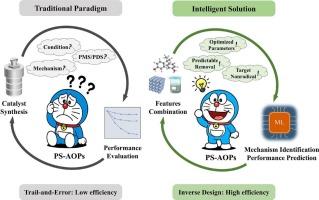Machine learning-driven design of nonradical persulfate activation process for water decontamination: a case of Cu-based catalysts
IF 4.3
2区 工程技术
Q2 ENGINEERING, CHEMICAL
引用次数: 0
Abstract
The rational design of heterogeneous persulfate activation systems with predictable mechanism remains a critical challenge for water decontamination. This study proposes a tripartite framework integrating “data-driven discovery, mechanistic decoding, and inverse design”, leveraging machine learning (ML) to simultaneously address the critical challenges of mechanism elucidation and performance prediction in persulfate-based catalysis. A comprehensive database encompassing 1,035 Cu-based catalyst datasets was constructed, enabling systematic evaluation of diverse ML algorithms. The developed Random Forest multi-classifier and CatBoost regressor achieved good performance in predicting dominant reaction mechanisms (radical/nonradical) and contaminant removal efficiency, respectively. To achieve genuine mechanistic decoding, we employed SHapley Additive exPlanations (SHAP) analysis. Moving beyond simple feature importance ranking, this approach quantifies the magnitude and direction of each feature’s contribution to individual predictions and provides nuanced insights into the underlying drivers of different catalytic pathways. Experimental validation demonstrated that their BPA removal rates in persulfate activation systems aligned remarkably with ML predictions (<12.5 %). Importantly, quenching experiments conclusively validated the model’s mechanistic predictions, confirming nonradical mechanism as the predominant contributor to the BPA removal in the designed Cu-based catalytic system. This work establishes a pioneering ML-aided catalyst design paradigm that bridges data science and environmental nanotechnology, advancing the intelligent, mechanism-aware water decontamination process.

非自由基过硫酸盐活化水净化工艺的机器学习驱动设计:以铜基催化剂为例
合理设计具有可预测机理的非均相过硫酸盐活化体系仍然是水净化的关键挑战。本研究提出了一个整合“数据驱动发现、机制解码和逆向设计”的三方框架,利用机器学习(ML)同时解决过硫酸盐催化中机制阐明和性能预测的关键挑战。构建了一个包含1,035个cu催化剂数据集的综合数据库,可以对各种ML算法进行系统评估。所开发的随机森林多分类器和CatBoost回归器分别在预测主要反应机制(自由基/非自由基)和污染物去除效率方面取得了良好的效果。为了实现真正的机械解码,我们采用了SHapley加性解释(SHAP)分析。这种方法超越了简单的特征重要性排序,量化了每个特征对个体预测的贡献的大小和方向,并提供了对不同催化途径的潜在驱动因素的细致见解。实验验证表明,它们在过硫酸盐活化系统中的BPA去除率与ML预测结果非常吻合(<12.5 %)。重要的是,猝灭实验最终验证了模型的机理预测,证实了在设计的cu基催化体系中,非自由基机制是去除BPA的主要机制。这项工作建立了一个开创性的机器学习辅助催化剂设计范例,将数据科学和环境纳米技术联系起来,推进了智能、机制感知的水净化过程。
本文章由计算机程序翻译,如有差异,请以英文原文为准。
求助全文
约1分钟内获得全文
求助全文
来源期刊

Chemical Engineering Science
工程技术-工程:化工
CiteScore
7.50
自引率
8.50%
发文量
1025
审稿时长
50 days
期刊介绍:
Chemical engineering enables the transformation of natural resources and energy into useful products for society. It draws on and applies natural sciences, mathematics and economics, and has developed fundamental engineering science that underpins the discipline.
Chemical Engineering Science (CES) has been publishing papers on the fundamentals of chemical engineering since 1951. CES is the platform where the most significant advances in the discipline have ever since been published. Chemical Engineering Science has accompanied and sustained chemical engineering through its development into the vibrant and broad scientific discipline it is today.
 求助内容:
求助内容: 应助结果提醒方式:
应助结果提醒方式:


